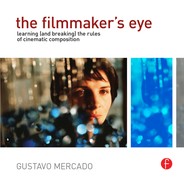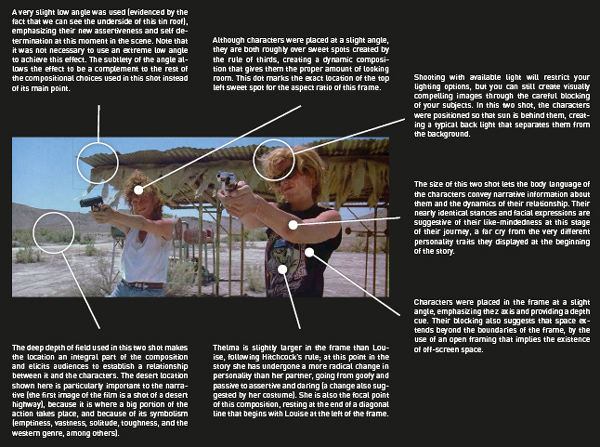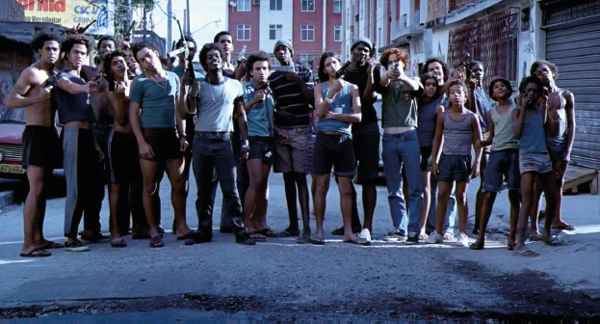two shot
As its name implies, the two shot includes two characters in the same composition. Two shots are usually accomplished using medium long, medium, and medium close ups, although any shot that features two characters can also technically be called a two shot. An extremely common use of the two shot is as a master shot for covering a conversation between two characters, either by itself or in coordination with other shots of various sizes, designed to shape the dramatic arc of the exchange. The blocking of the characters in a two shot can make a vivid narrative point about the dynamics of their relationship; this is true of any shot that includes multiple characters, like group shots, but it is particularly important for two shots, because having only two characters in a composition instantly suggests there is a connection between them and elicits the audience to compare and contrast them. For instance, you could use Hitchcock’s rule to let one character occupy more space within the composition, suggesting he or she has more power, control, or assertiveness than the other. Alternatively, if the two shot uses a medium or a long shot, the body language of your characters could also be used to suggest a particular dynamic between them. One important aspect to be aware of when using only a two shot to cover a conversation is that the audience will “edit” the scene themselves, by shifting their attention from one character to the other depending on which one is talking or any other aspect of their performance. While this might seem like a trivial distinction, it can have a serious impact in the way your audience engages with the story. When you use a combination of increasingly tighter shots to suggest something meaningful is taking place, the audience can afford to be passive, since the context of the scene is being revealed to them by the progression of the shots through editing. When the composition stays constant and no editing is used, the audience has to become active, constantly searching for clues to decode the dramatic intent of the scene (what André Bazin, a seminal film theorist, called the “mise-en-scène aesthetic”).
Jim Jarmusch uses this strategy in the “Far From Yokohama” segment of his film Mystery Train (1989). The story follows a teenage Japanese couple (Masatoshi Nagase and Youki Kudoh) as they visit historical blues and rock & roll landmarks in Memphis, Tennessee. Almost every shot in this segment is a two shot, suggesting both the deep connection that exists between them (even though they spend a large amount of their time arguing) and the shared isolation they experience as outsiders in a strange land. Because of the predominant use of two shots to tell their story, the exact nature of their relationship is revealed gradually, through their actions and performance, rather than by the strategic use of point of view shots and close ups.
The “Far From Yokohama” segment in Jim Jarmusch’s Mystery Train (1989) uses mostly two shots, suggesting the strong connection that exists between Jun (Masatoshi Nagase) and Mitsuko (Youki Kudoh), as they make a musical pilgrimage to Memphis, Tennessee.
two shot
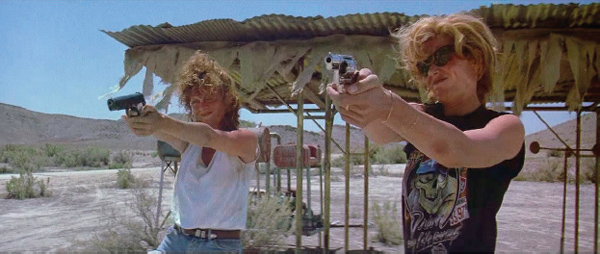
why it works
Two shots, like other shots that include multiple characters, let you establish the dynamics of a relationship, through body language, blocking, and the composition of the shot. However, because two shots only include two characters, their use tends to automatically imply that some type of narrative connection exists between them as well. This two shot from Ridley Scott’s Thelma & Louise (1991), the story of two women who become wanted fugitives after one of them shoots and kills a would-be rapist, is used to establish the new relationship they have forged as a result of their journey together. By the time this two shot is used, Louise (Susan Sarandon, left), a waitress with a damaged past who mistrusts men, and Thelma (Geena Davis, right), a mousy housewife with a controlling husband, have turned into hard core “bitches from hell” (to quote one character in the film) as they right the wrongs of the patriarchal system. Every aspect of the composition of this shot, from their body language to their placement within the frame, is designed to convey how alike their plight has made them.
technical considerations
lenses
Since two shots can come in a variety of sizes (anywhere from a medium close up to an extreme long shot), your choice of focal length will be determined by the specific needs of your story. Depending on the kind of relationship you want the audience to infer between the subjects, you can use a telephoto lens that makes it look as if the space between them along the z axis is shorter than in real life, or a wide angle lens to suggest they are farther apart. If the two shot includes a sizable portion of their surrounding area, you can also choose a focal length to affect the spatial relationships between subjects and a location. Look at the different ways characters and their environment are portrayed in the example from Mystery Train (at the beginning of this chapter) where only a small portion of the background is included in the frame, and the one from Thelma & Louise (on the previous page) where a large area surrounding them is visible in the shot. In these examples, the focal length and camera to subject distance were selected to manipulate the field of view in the composition of the shot, placing the dramatic emphasis selectively on the characters, or on both characters and location, as their narratives required.
format
The two main disadvantages of shooting with SD and HD prosumer formats instead of film (the low sensitivity of their CCD sensors and their general inability to produce shallow depth of field), are especially limiting in shots that have multiple visual elements, like two shots. While it would be possible to shoot the exact composition and depth of field seen in the Thelma & Louise example with almost any digital camera, only a prosumer HD camera equipped with a 35mm lens adapter kit or a professional HD camera could replicate the framing and depth of field seen in the example from Mystery Train. But do not let this discourage you from incorporating the limitations of a format into the visual strategy of your film; instead, learn to exploit them and use them to your advantage.
lighting
At the very least, a two shot will include two characters and some portion of the surrounding area in the background. Commonly, characters are lit so that they stand out in the composition by making sure they are slightly brighter than anything else in the frame; with two shots, controlling how much brighter than the background they are can be used as a narrative device. If the background is kept much darker than the characters, it will be difficult to convey a relationship between the subjects and the background (as shown in the example from Mystery Train). Alternatively, the background can be lit so that it is perceived as being just as or even more important than the characters, underlining the relationships that might exist between them (in the example from Thelma & Louise, for instance, the background is as bright as they are, while the two shot from Paris, Texas on the opposite page features a background that is brighter than both characters). Lighting can also be used to control what elements in the frame are in and out of focus, through the manipulation of depth of field. You could ensure that the background of a two shot falls outside the area of sharp focus by using a wide aperture that produces a shallow depth of field, or ensure that it is seen clearly by using a small aperture that gives you a deep depth of field. But you cannot simply open or close the aperture without affecting the exposure of your image, so having control over the lighting becomes crucial, especially when shooting indoors (where having the extra lights necessary to use a small aperture might not be an option). Day exteriors will present you with the opposite problem; you might have too much light and need to use ND filtration if you want to use a large aperture to have shallow depth of field.
breaking the rules
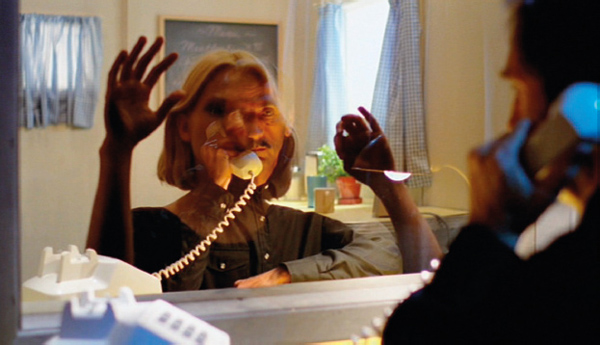
This imaginative two shot (technically also an over the shoulder shot) from Wim Wenders’ Paris, Texas (1984), brilliantly visualizes a key moment in the story, as Travis (Harry Dean Stanton), a man who deserted his family and became a drifter, reveals himself to his wife Jane (Nastassja Kinsky) at the peep show club where she works. The composition uses a one-way mirror to create a two shot that merges both characters and captures the dynamics of their relationship; Travis sees his reflection superimposed over an idealized version of the home and wife he left behind and wants to regain, but the optical illusion that lets him see his goal realized also reveals how illusory it remains, and he ultimately decides that his family is still better off without him. Because this two shot conveys so many aspects of the story by itself, it is also a great example of an emblematic shot.
City of God. Fernando Meirelles & Katia Lund, 2002.
